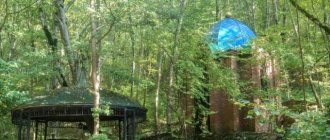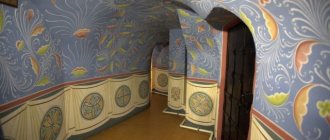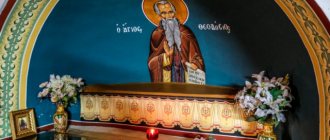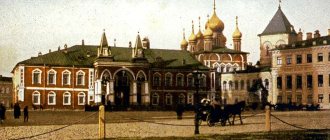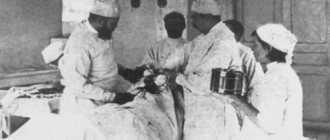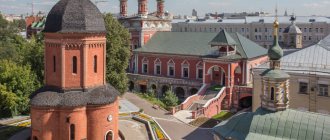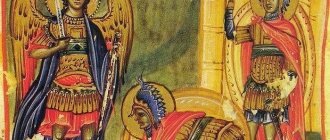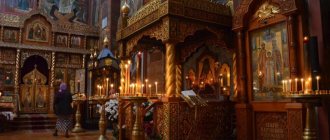Saint Theodosius, angel of the Chernigov church
Yeletsky Chernigov Church of the Dormition of the Virgin Mary
Several years ago, a group of Kharkov residents went on a long trip around Ukraine and covered 3,500 km. On the way, one of the first cities filled with Russian ancient shrines was the beautiful Chernigov.
First, the road itself led us to the Yeletsky (Yelsky) Assumption Monastery, located on Boldinaya Mountain. The monastery was founded in the 11th century by the Grand Duke of Chernigov Svyatoslav Yaroslavich on the advice of someone who labored here in 1069-1072. the founder of Russian monasticism, Venerable. Anthony of Pechersk. In ancient times, the monastery was large, rich and well-maintained, but later it was destroyed by the Tatars and Poles. In 1240 it was burned by Batu along with the city, restored in 1445. In 1579 and 1611 it was destroyed by Polish troops. The monastery began to be restored in 1657 under the Chernigov archpastor Lazar Baranovich. The abbots of the monastery at different times were persons very famous in the history of the Russian Church: Ioannikiy Golyatovsky, Demetrius of Rostov and Theodosius of Chernigov (also called Uglichsky).
The cathedral monastery church in the name of the Dormition of the Blessed Virgin Mary, built in 1060, was renovated in the 15th century. and the beginning of the 17th century.
Here in the iconostasis was the Yelets Chernigov Icon of the Mother of God “The Unfading Flower,” which appeared in 1060 near Chernigov on a spruce tree, which is why it got its name. In the history of the Russian Church, the appearance of an icon on a tree was the first such miracle.
After the destruction of the monastery at the beginning of the 17th century. the icon was lost. In 1676, the brothers Matvey and Nikita, named Kozel (Kozel), brought here from Vladimir an exact copy of the Yeletsky image, which was purchased from them by the prince. K. Ostrogsky and donated to the monastery. The ancient Yeletsk Chernigov icon was considered to be the one that in 1579 by the descendants of Svyatoslav of Chernigov, Prince. The Baryatinskys were taken to Moscow, and in 1687 on the Crimean campaign. On the way back (in the same year), the dying Daniil Baryatinsky gave the icon to the Kharkov Assumption Cathedral.
The celebration in honor of the Yelets Chernigov Icon took place on February 5, that is, the 18th according to the new style. Years later, on the same day, the memory of St. Theodosius of Chernigov began to be venerated.
Icon of the Mother of God Yeletskaya Chernigov
Under the monastery church in honor of St. App. Peter and Paul and the bishop's chambers were the Yelets caves, excavated under the Venerable. Anthony of Pechersk. The location and structure of these caves is similar to those in Kyiv. To the west of the monastery bell tower there was a wooden house, where under the ceiling there was a beam with a carved inscription: “St. Theodosius of Uglitsky, archimandrite 1688.” This beam was in the cell of St. Feodosia.
On the Boldin Mountains we climbed the 58-meter bell tower of the Trinity Cathedral, built in 1775 according to Rastrelli’s design. Rastrelli is memorable, in particular, for being the architect of the project for the Assumption Cathedral in Kharkov.
Trinity Cathedral of Chernigov
The Trinity Cathedral itself was founded in 1679 according to the design of the German John Baptist from Vilna. In the right nave of the cathedral there is now a shrine of the holy wonderworker Theodosius of Uglitsky and Chernigov. And the wooden house, which is more than three hundred years old, where the great Theodosius lived, remains to this day on the territory of the Yeletsky Monastery.
In the Trinity Cathedral we also venerated the icon of the Chernigov Mother of God - the second miraculous icon of Chernigov, universally revered along with the icon of the Yelsk Mother of God.
* * *
Saint Theodosius, Archbishop of Chernigov, was born in the early 1630s in the Podolsk province. He came from the ancient noble family of Polonitsky-Uglitsky. His parents were priest Nikita and Maria.
Saint Theodosius, Archbishop of Chernigov. Icon
Theodosius, who was distinguished from childhood by his meekness and diligence in prayer, discovered his natural abilities at the Kiev Brotherhood College at the Kiev Epiphany Monastery. This was the heyday of the college, when its rectors were Archimandrite Innocent (Gisel), and then the abbot and subsequently the Archbishop of Chernigov - Lazar (Baranovich). Among his mentors were Hieromonk Epiphanius (Slavinetsky), Hieromonk Arseny (Satanovsky), Bishop of Belarus Theodosius (Baevsky), Abbot Theodosius (Safonovich) and Meletius (Dzik). Saint Theodosius's comrades in the college were future outstanding shepherds: Simeon of Polotsk, Ioannikiy Golyatovsky, Anthony of Radziwill, Varlaam Yasinsky.
At that time, the Kiev-Brotherly Epiphany School was the main center of the struggle of Orthodoxy against the attacks of the Catholic clergy, Jesuits and Uniates.
The future saint took monastic vows at the Kiev-Pechersk Lavra with the name Theodosius, in honor of the Venerable Theodosius of Pechersk. By the Kyiv Metropolitan Dionysius (Balaban) he was appointed archdeacon of the Kiev-Sophia Cathedral, but soon left for the Krutitsky monastery of the Chernigov diocese near Baturin, expecting a strict monastic life. There he accepted the rank of hieromonk.
In 1662, Theodosius was appointed abbot of the Korsun monastery of the Kyiv diocese, and in 1664 - rector of the ancient Kiev-Vydubitsky monastery. This monastery had previously been in the hands of the Uniates and was completely ruined. But Saint Theodosius, thanks to his energy and perseverance, managed to quickly revive the monastery. He created a wonderful choir, which was famous not only in Little Russia, but also in Moscow, where Saint Theodosius sent his singers in 1685.
When you look at the history of this monastery, you think that it is destined for some special stoic role. When St. Feodosia she had to go through a difficult period. Nowadays, it has been captured by self-sanctified schismatics of the “Kyiv Patriarchate”.
The Right Reverend Lazar (Baranovich) called Abbot Theodosius “a sheep of the flock of Christ who has learned obedience.” Having become the locum tenens of the Kyiv Metropolis in 1679, remaining in Chernigov, he appointed Theodosius as his Kyiv governor. In this capacity, St. Theodosius was sent to Moscow in 1685. As a result, a most important event occurred: the reunification of the Kyiv Metropolis with the Russian Church.
In 1688 St. Theodosius was appointed to the Yeletsky Monastery in place of the deceased Archimandrite Ioannikis (Golyatovsky). It was from then on that the saint became constantly associated with Chernigov.
The saint had to work hard in the Yelets monastery, which was devastated by the Jesuits and Dominicans. Over the course of several years, the monastery restored its prosperity. Yelets Archimandrite provided significant assistance to His Eminence Lazar. For example, he participated in the drafting of a conciliar response to Moscow Patriarch Joachim to his question letters about the attitude of the Kyiv Metropolis to the Florence Council. When the patriarch was not satisfied with these answers, the abbot of Baturin, Saint Demetrius (Tuptalo), the future Metropolitan of Rostov, was sent to Moscow at the beginning of 1689. St. Theodosius traveled with him as a representative from the Right Reverend Lazarus. He was instructed to convey a response letter to His Holiness and verbally clarify all the misunderstandings between Moscow and Kiev. At the same time, the order given to Archimandrite Theodosius was supposed to indicate him as a trusted person who deserves special attention from the patriarch and the Moscow government.
In a petition to Emperor Peter I and the Patriarch, sent on behalf of the people by His Grace Lazar and the Hetman, the high merits of the future saint were pointed out: “The Most Honorable Archimandrite, a good man, adorned with the virtues of the monastic life, which he has led from a young age, experienced in the management of monasteries, filled with fear God and spiritual experience, enlightened, very zealous for church splendor, capable of managing the house of the pulpit and the diocese of Chernigov.”
September 11, 1692 St. Theodosius, having presented a personally signed oath to the “Archbishop of Moscow and all Russia and all northern countries, Patriarch” Adrian, was named Archbishop of Chernigov and Novgorod (Novgorod-Seversk). And on September 13 he was consecrated archbishop in the Assumption Cathedral of the Moscow Kremlin. In the issued St. Theodosius, at his own request, the royal charter, which confirmed the rights of the Chernigov archbishops, indicated dependence not on the Kyiv Metropolitan, but on the Moscow Patriarch.
To St. Not only Orthodox Christians, but also people of other confessions turned to Theodosius for help and advice. He especially patronized Chernigov theological schools and invited learned monks from Kyiv, among whom was Hieromonk John (Maksimovich). It was he, then the abbot of the Bryansk Svensky Monastery, who was called by St. Theodosius, feeling the approach of his death, appointed the Yelets Monastery as archimandrite of Chernigov.
On February 18 (New Art.), 1696, Saint Theodosius died.
Subsequently, the future Metropolitan of Tobolsk and All Siberia John (Maksimovich) built a brick vault with a laudatory inscription in verse over his coffin in the Chernigov Boris and Gleb Cathedral behind the right choir in gratitude for his miraculous healing from a serious illness.
Saint Theodosius, Archbishop of Chernigov. Tree. Thread. End of the 19th century
The glorification of Saint Theodosius took place on September 9, 1896, on the eve of the 200th anniversary of his death. The great veneration of the Chernigov saint is evidenced by the fact that about 150 thousand pilgrims arrived for the celebrations in Chernigov, a city of thirty thousand. The definition of the Holy Synod read: “In the blessed memory of the late Theodosius, Archbishop of Chernigov, be canonized as saints, Orthodox by the grace of God, and recognize his incorruptible body as holy relics. The memory of the saint is celebrated on February 5 and on the day of the opening of the relics of the saint, and for the celebration of the opening of the relics of the saint, in fulfillment of the HIGHEST will of the Sovereign Emperor NICHOLAS II, set the 9th day of September of the current 1896.” (February 18 and September 22, respectively, according to the new style. - Author)
Sugar manufacturer N.A. Tereshchenko, the same one who, like V. Tretyakov, collected a collection of Russian paintings (now the Kiev National Museum of Russian Art), donated a silver and gilded sarcophagus for the relics of the saint. The reliquary with the relics of Theodosius was solemnly transferred from Borisoglebsky to the Cathedral of the Transfiguration of the Savior and placed in a sarcophagus. A year later, Fr. arrived from St. Petersburg to venerate the relics of St. Theodosius. John Sergiev (holy righteous John of Kronstadt) and spent two days in Chernigov.
After the October Revolution of 1917, the incorruptible relics of the saint served as a reason for “debunking the priest’s miracles.” But it misfired. “Military urgent telegram. To the head of the political section of Right Bank Ukraine. Kyiv. By resolution of the Provincial Congress of Soviets 18/2 (1921), the relics of St. Theodosius were uncovered in Chernigov. The autopsy turned out to be extremely unsuccessful. The body was intact and hardened. The mood of the masses is tense. The medical expert commission issued a biased decision. The provincial executive committee asked Kharkov to expel archaeological professors - the latter needed to establish the soil composition of the Chernihiv region. If there are the required people (in) Kyiv, inform them and send them (to) Chernigov. We are conducting a successful campaign, an anti-religious week has been declared. I will personally send you the details of the autopsy report. Secretary of the State Council (Sokolov).”
However, the mockery continued: the relics of St. Feodosia (unclothed!) were exhibited first in Ukraine, then in Moscow and, finally, by the end of the 1920s in Leningrad, where a museum of religion and atheism began operating in the Kazan Cathedral. Here, decades later, in the early 1990s, the relics of St. Seraphim of Sarov and St. Joasaph of Belgorod.
By the end of the 1930s, there was no longer a single functioning church in the ancient saint of Chernigov.
Let us note that Chernigov was liberated from the Nazi invaders on September 21, 1943, on the day of the Nativity of the Virgin Mary, on the eve of the feast of the glorification of St. Feodosia.
They tell an amazing story. During the defense of Leningrad, participants in a meeting of the military council heard a voice: “Ask (pray) Saint Theodosius, he will help you.” They tried to find out who Theodosius was. The search led them to Metropolitan Alexy (Simansky) of Leningrad, who continued serving in the besieged city, later Patriarch of Moscow and All Rus'. The relics of the saint were transferred to St. Nicholas Cathedral, where the service began.
They say that that same night, severe frost shackled Ladoga, making it possible to deliver food, ammunition, manpower and equipment to the depleted city, as well as to evacuate those in need of urgent removal.
From history we remember the phrase “Road of Life,” but few people know that the Orthodox called it “the road of St. Theodosius.”
They also say that immediately after the war, thanks to the personal participation of the new Patriarch Alexy I (Simansky) and I. Stalin, the power of St. Theodosius were returned to Chernigov, where vigilant akathists were already being served. A majestic, uplifting picture: on September 15, 1946, the Orthodox came out to meet St. Theodosius, who was returning to his hometown, and his incorruptible relics. Rev. who predicted the return. Lavrentiy of Chernigov (Proskura, +1950) walked with a candle, like all the monastics, like all the people, of whom there were not very many. The service in the Trinity Cathedral was Easter, they sang “Christ is Risen!” A participant in the celebrations excitedly said: “Father Lavrenty led the choir and the entire parade, Vladyka served... Saint Theodosius served, and Vladyka was a colleague. The relics were carried out to the pulpit, to the salt, and placed in a high place. We all had big candles. It was an extraordinary service, an extraordinary celebration!”
The Trinity Monastery was closed in 1962, the relics of St. Theodosius were lowered into the basement of the Trinity Cathedral in the tomb of the Chernigov bishops. It was only in 1984 that they again became available to believers.
The radioactive cloud formed on April 26, 1986 as a result of the accident at the Chernobyl nuclear power plant bypassed the city. Chernigov residents are confident that they were saved by the patron saint of the city, St. Theodosius. The liquidators of the Chernobyl accident also consider the saint their patron. In 2009, the construction of a temple in Kyiv in honor of the saint was completed.
Temple in honor of St. Theodosius of Chernigov in Kyiv
A new temple complex of St. Theodosius of Chernigov and in Kyiv Darnitsa, together with the temple in honor of the icon of the Mother of God “Joy of All Who Sorrow.”
Temple complex of St. Theodosius of Chernigov in Darnitsa
A temple is being built in honor of St. Theodosius of Chernigov and in the village. Petrishki in Minsk region is the first in Belarus.
Thus, for many centuries, the Chernigov Saint Theodosius continues his loving unifying ministry among the Orthodox people, which must be remembered in the year of the 1025th anniversary of the Baptism of Rus'.
His Beatitude Metropolitan of Kiev and All Ukraine Vladimir at the relics of St.
Theodosius of Chernigov https://odnarodyna.com.ua/node/12152
Prayers
Troparion
You were elevated to the rank of bishop, Saint Theodosius, / you were the luminary of your flock, / you also reposed in the eternal Abode. / Beg from the Throne of the King of Glory to deliver us from the evils that befall us / and to save our souls, holy ones, / through your prayers.
Kontakion, tone 4
You worked as a shepherd for the Chief of Christ, Saint Theodosius: / feeding your verbal sheep in the spiritual pasture, / and you received from Christ the Savior the healing gift / to heal the mental and physical infirmities of everyone who comes with faith to your healing power. / Pray, holy one, for those who call on your name, / to save our souls from the slander of the enemy.
